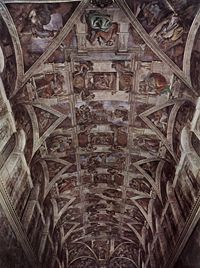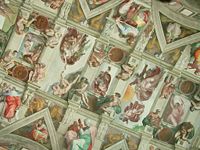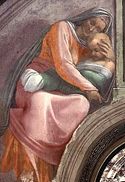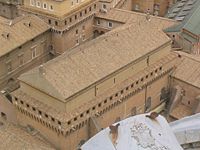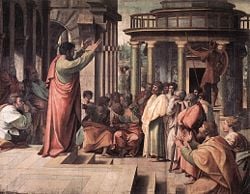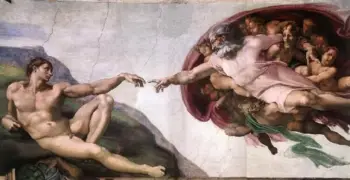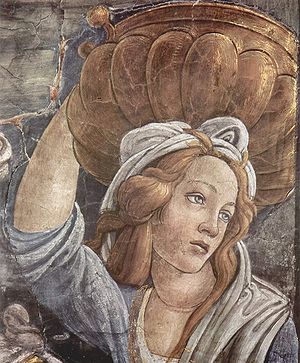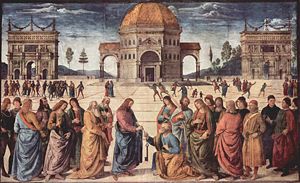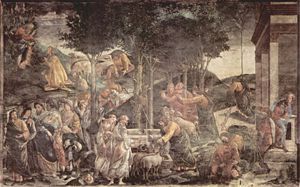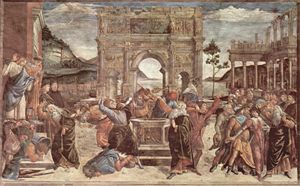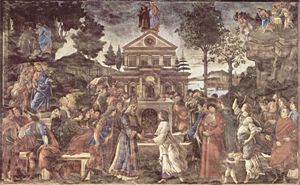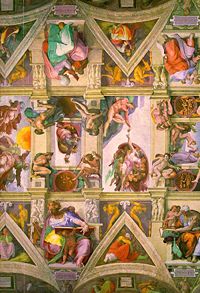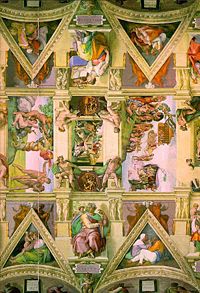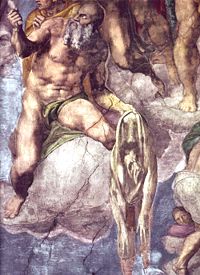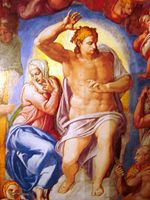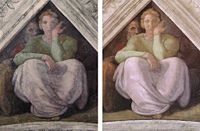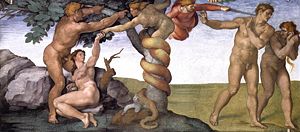Sistine Chapel
The Sistine Chapel (Italian: Cappella Sistina) is a chapel in the Apostolic Palace, the official residence of the Pope, in Vatican City. Its fame rests especially on its decoration, frescoed throughout by the greatest Renaissance artists, most notably Michelangelo Buonarroti, whose ceiling is legendary. Named for Pope Sixtus IV, the chapel is also noted for its architecture, which evokes Solomon's Temple of the Old Testament. It serves as a site of papal religious and functionary activity, notably the conclave, at which a new Pope is selected.
Due to the extraordinary talents of Michelangelo (1475-1564), the Sistine Chapel has become one of the most famous art displays in the western world. The famous Sistine ceiling depicts scenes from Genesis in striking detail, and The Last Judgment on the chapel's end wall is equally dramatic. In addition to these famous artworks, the side walls are festooned with frescoes of Moses and Christ and portraits of popes.
In recent decades, the Sistine Chapel has been fastidiously cleaned and restored, beginning with the fifteenth-century wall frescoes in 1965. The cleaning and restoration of the lunettes, the ceiling, and the Last Judgment, a painstaking process using computer analysis, lasted from 1980 to 1994. The restoration included the removal of several of the "modesty" drapes that had been added over some of the nude figures.
The end result of the restoration has been controversial: Critics say a vital, second layer of paint was removed, and argue that many of the restored figures seem flat compared with the originals, which had more shadow and detail. Others have hailed the project for saving Michelangelo's masterpiece for future generations to appreciate and for revealing the vibrancy of his color palette.
Purpose and history
Outside of its art, the Sistine Chapel is most famous for being the place where Papal Conclaves take place for the election of a new pope. Lesser known is that the chapel also houses a corporate body known as the Papal Chapel. At the time of Pope Sixtus IV in the late-fifteenth century, this body comprised about 200 persons, including clerics, officials of the Vatican, and distinguished laity.
The Papal calendar prescribes 50 occasions during the year that the entire Papal Chapel should meet. Of these, most are masses, of which eight are held in basilicasâgenerally St. Petersâand are attended by large congregations. These include the Christmas Day and Easter masses, at which the Pope himself is the celebrant. The other masses can be held in a smaller, less-public space, such as the Sistine Chapel, which was built on the site of its predecessor, the Cappella Maggiore that in its time served the same purpose.
The Cappella Maggiore derived its name, translated as the Greater Chapel, from the fact that there was another chapel also in use by the Pope and his retinue for daily worship. At the time of Pope Sixtus IV, this was the Chapel of Pope Nicholas V, which had been decorated by Fra Angelico. The Cappella Maggiore is recorded as existing in 1368, but by the time of its demolition to make way for the present chapel, the Cappella Maggiore was in a ruinous state with its walls leaning.
The present chapel was designed by Baccio Pontelli for Pope Sixtus IV, for whom it is named, and built under the supervision of Giovannino de Dolci between 1473 and 1484. After its completion, the chapel was decorated with frescoes by a number of the most famous artists of the late-fifteenth century, including Botticelli, Ghirlandaio, and Perugino.
The first mass in the Sistine Chapel was celebrated on August 9, 1483, the Feast of the Assumption, at which the chapel was consecrated and dedicated to the Virgin Mary.
The Sistine Chapel has maintained its function to the present day, and continues to host the important services of the Papal calendar, unless the Pope is traveling. It also houses a permanent choir, for whom much original music has been written, the most famous piece being Allegri's Miserere, a setting of the psalm for Maundy Thursday.
Architecture
Exterior
The Sistine Chapel is a high rectangular brick building; its exterior unadorned by architectural or decorative details, as is common in many Italian Medieval and Renaissance churches. It has no exterior facade or processional doorways, since access is from internal rooms within the Papal Palace. The chapel's internal spaces are divided into three stories, of which the lowest is a robustly vaulted basement with several utilitarian windows and a doorway onto the exterior court.
Above is the main space, the chapel, with internal measurements of 134 feet long by 44 feet wide, thought to be the same dimensions as the Temple of Solomon noted in the Old Testament. The vaulted ceiling rises to 68 feet. The building has six tall, arched windows down each side and two at either end, several which have been blocked.
Above the vault rises a third story with wardrooms for guards. Encircling the building at this level is an open projecting gangway, supported by an arcade protruding from the walls. The building is roofed with pantile tiles. The sinking and cracking of masonry, has necessitated the addition of large buttresses to brace the exterior walls.
Interior
There ratio between the length, width, and height of the interior chapel is 6:2:3. The ceiling of the chapel is a flattened barrel vault that is cut transversely by smaller vaults over each window. The barrel vault was originally painted brilliant blue and dotted with gold stars, to the design of Pier Matteo d'Amelia. The pavement is in opus alexandrinum, a decorative style using marble and colored stone in a pattern that reflects the earlier proportion in the division of the interior. It also marks the processional way from the main door, used by the Pope on important occasions such as Palm Sunday.
A screen or transenna in marble by Mino da Fiesole, Andrea Bregno, and Giovanni Dalmata divides the chapel into two parts. Originally these made equal space for the members of the Papal Chapel within the sanctuary near the altar and for the pilgrims and townsfolk without. However, with growth in the number of those attending the Pope, the screen was moved giving a reduced area for the laity. The transenna is surmounted by a row of ornate candlesticks, once gilt, and has a wooden door, where once there was an ornate door of gilded, wrought iron. The sculptors of the transenna also provided the cantoria, or projecting choir gallery.
During important, occasional ceremonies, side walls are covered with a series of tapestries. These were originally designed for the chapel by Raphael, and his drawings for them still exist. The tapestries themselves were looted by the French armies and scattered around Europe. The tapestries depict events from the Life of St. Peter and the Life of Saint Paul, as described in the Gospels and the Acts of the Apostles.
Decoration
The pictorial decoration of the Sistine Chapel is comprised of frescoes and a set of tapestries. They are the work of different artists and are part of a number of different commissions, some of which were in conflict with each other.
The walls are divided into three main tiers. The lower is decorated with frescoed, wall hangings in silver and gold. The central tier of the walls has two cycles of paintings, which complement each other, The Life of Moses and The Life of Christ. The upper tier is divided into two zones. At the lower level of the windows is a Gallery of Popes painted at the same time as the Lives. Around the arched tops of the windows are areas known as the lunettes which contain the Ancestors of Christ, painted by Michelangelo as part of the scheme for the ceiling.
The ceiling, commissioned by Pope Julius II and painted by Michelangelo from 1508 to 1511, has a series of nine paintings showing God's Creation of the World, God's relationship with Mankind and Mankind's fall from God's Grace. On the large pendentives that support the vault are painted 12 Biblical and Classical men and women who prophesied that God would send Jesus Christ for the salvation of mankind.
Subsequently, Raphael was commissioned by Pope Leo X to design a series of tapestries to hang around the lower tier of the walls. These depict the lives of the two leaders among the Apostles who established the Christian church in Rome, Saints Peter and Paul.
Although Michelangelo's complex design for the ceiling was not quite what his patron, Pope Julius II, had in mind when he commissioned Michelangelo to paint the Twelve Apostles, the scheme displayed a consistent iconographical pattern. However, this was disrupted by a further commission to Michelangelo to decorate the wall above the altar with The Last Judgment, 1537-1541. The painting of this scene necessitated the obliteration of two episodes from the Lives, several of the Popes and two sets of Ancestors. Two of the windows were blocked and two of Raphael's tapestries became redundant.
Wall frescos
The wall paintings were executed by premier painters of the fifteenth century: Perugino, Botticelli, Ghirlandaio, Rossellini, Signorelli, and their respective workshops, which included Pinturicchio, Piero di Cosimo, and Bartolomeo della Gatta. The subjects were historical religious themes, selected and divided according to the medieval concept of the partition of world history into three epochs: before the Ten Commandments were given to Moses, between Moses and Christ's birth, and the Christian era thereafter. They underline the continuity between the Old Covenant and the New Covenant, or the transition from the Mosaic law to the Christian religion.
The walls were painted over an astonishingly short period of time, barely 11 months, from July 1481 to May 1482. The painters were each required first to execute a sample fresco; these were to be officially examined and evaluated in January 1482. However, it was so evident at such an early stage that the frescoes would be satisfactory that by October 1481, the artists were given the commission to execute the remaining ten stories.
The pictorial arrangement for the chapel was comprised of a cycle each from the Old and New Testament depicting scenes from the lives of Moses and Christ. The narratives began at the altar wallâthe frescoes painted there yielding to Michelangelo's Last Judgment a mere 30 years laterâcontinued along the long walls of the chapel, and ended at the entrance wall. A gallery of papal portraits was painted above these depictions, and the latter were completed underneath by representations of painted curtains. The individual scenes from the two cycles contain typological references to one another. The Old and New Testament are understood as constituting a whole, with Moses appearing as the prefiguration of Christ.
The typological positioning of the Moses and Christ cycles has a political dimension going beyond a mere illustrating of the correspondences between Old and New Testament. Sixtus IV was employing a precisely conceived program to illustrate through the entire cycle, the legitimacy of papal authority running from Moses, via Christ, to Peter and ultimately to the present Pope. The portraits of the latter above the narrative depictions served emphatically to illustrate the ancestral lineage of their God-given authority.
Among Pietro Perugino's frescoes in the chapel, the Christ Giving the Keys to Saint Peter is stylistically the most instructive. These keys represent the power to "bind and loose" on earth and in heaven and are particularly significant in papal theology, which sees the Pope as the inheritor of Peter's keys, and thus the "Vicar of Christ."
Botticelli's work
Sandro Botticelli painted three scenes within the short period of 11 months: Scenes from the Life of Moses, The Temptation of Christ, and The Punishment of Korah. He also painted (with help from his workshop) some portraits of popes, which have been considerably painted over.
The Scenes of the Life of Moses fresco is opposite The Temptation of Christ, also painted by Botticelli. As the Moses cycle starts on the wall behind the altar, the scenes unfold from right to left: (1) Moses angrily strikes an Egyptian overseer and then (2) flees to the Midianites. There (3) he disperses a group of shepherds who were preventing the daughters of Jethro from (4) drawing water at the well. After (5, 6) the divine revelation in the burning bush at the top left, Moses obeys God's commandment and (7) leads the people of Israel in a triumphal procession from slavery in Egypt.
Some believe that the message of this Botticelli's The Punishment of Korah provides a key to an understanding of the Sistine Chapel as a whole, before Michelangelo's work. The fresco reproduces three episodes, each of which depicts a rebellion by the Hebrews against God's appointed leaders, Moses and Aaron, along with the ensuing divine punishment of the agitators. Korah was a Levite who challenged the idea that the priesthood belong only to Aaron and his sons, on the basis that the whole congregation of the Israelites was holy. The principal message of these scenes is made manifest by the inscription in the central field of the triumphal arch: "Let no man take the honor to himself except he that is called by God, as Aaron was."
In the Temptation of Christ Botticelli depicts Jesus' threefold temptation by the Devil, as described in the Gospel according to Matthew, can be seen in the background of the picture, with the devil disguised as a hermit. At top left, up on the mountain, he is challenging Christ to turn stones into bread; in the center, we see the two standing on a temple, with the Devil attempting to persuade Christ to cast himself down; on the right-hand side, finally, he is showing the Son of God the splendor of the world's riches, over which he is offering to make Him master. However, Christ drives away the Devil, who ultimately reveals his true devilish form.
Michelangelo's painting
Michelangelo Buonarroti was commissioned by Pope Julius II in 1508 to repaint the ceiling, originally representing golden stars on a blue sky; the work was completed between 1508 and November 1511. He painted the Last Judgment over the altar, between 1535 and 1541, being commissioned by Pope Paul III Farnese. Michelangelo felt that he was a more developed sculptor than a painter, but he accepted the offer.
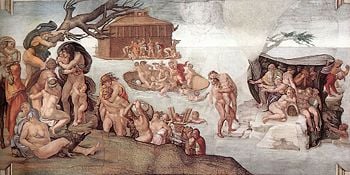
Michelangelo painted the vault, or ceiling, of the chapel. To be able to reach the ceiling, Michelangelo needed a support; the first idea was by Bramante, who wanted to build him a special scaffold, suspended in the air with ropes. But Michelangelo suspected that this would leave holes in the ceiling once the work ended, so he built a scaffold of his own, a flat, wooden platform on brackets built out from holes in the wall, high up near the top of the windows. He stood on this scaffolding while he painted.
The first layer of plaster began to grow mold because it was too wet. Therefore, Michelangelo had to remove it and start again, so he tried a new mixture of plaster, called intonaco, which was resistant to mold. It was created by one of Michelangelo's assistants, Jacopo l'Indaco, and is still in use today.
Michelangelo used bright colors, easily visible from the floor. On the lowest part of the ceiling he painted the ancestors of Christ. Above this he alternated male and female prophets, with Jonah over the altar. On the highest section Michelangelo painted nine stories from the Book of Genesis.
The artist was originally commissioned to paint only 12 figures, the Apostles. He turned down the commission because he saw himself as a sculptor, not a painter. The Pope offered to allow Michelangelo to paint biblical scenes of his own choice as a compromise. When the work was finished there were more than 300. His figures showed the creation, Adam and Eve in the Garden of Eden and the Great Flood.
Michelangelo's inspirational, biblical images covering the Sistine Chapel's ceiling were imbued with a special significance due to the immediacy of the pope. For this reason, his artwork took on the significance of religious icons, which to this day inform the public notion of biblical imagery and theological meaning.
Last Judgment
The Last Judgment was painted by Michelangelo from 1535-1541, after the Sack of Rome in 1527 by Protestant forces from the Holy Roman Empire, which effectively ended the Roman Renaissance, and just before the Council of Trent, a time of great uncertainty as to the future of the Church.
The work is massive and spans the entire wall behind the altar of the Sistine Chapel. The Last Judgment is a depiction of the second coming of Christ and the apocalypse. The souls of humanity rise and descend to their fates as judged by Christ and his saintly entourage. The wall on which The Last Judgment is painted cants out slightly over the viewer as it rises, and is meant to be somewhat fearful and to instill piety and respect for God's power. In contrast to the other frescoes in the chapel, the figures are heavily muscled and appear somewhat tortured. Christ is depicted especially powerfullyâeven the Virgin Mary at the center appears to cower beneath him.
The Last Judgment was an object of a heavy dispute between Cardinal Carafa and Michelangelo: the artist was accused of immorality and intolerable obscenity, having depicted naked figures, with genitals in evidence, so a censorship campaign (known as the "Fig-Leaf Campaign") was organized by Carafa and Monsignor Sernini to remove the frescoes.
The genitalia in the fresco were later covered by the artist Daniele da Volterra, whom history remembers by the derogatory nickname "Il Braghettone" ("the breeches-painter").
Restoration and controversy
The chapel has been recently restored (1981 through 1994). This restoration was initially surrounded by a heated controversy in the art world, some claiming it a success and a breakthrough revelation, while a few claiming it ruined the masterpiece. Some conservationists complained about the loss of a brown patina that had developed over centuries, composed of candle smoke, soot, and repeated applications of poor quality varnish.
The newly-revealed bright colors reveal Michelangelo to have been a masterful colorist, and close-ups of the frescoes show complex brushwork that would not be matched, nor even attempted, until the Impressionist movement of the nineteenth century. Others comment that bright colors were necessary for the frescoes to stand out in the gloom of the chapel, with its high, narrow windows. Now that the electric lighting has been removed and the frescoes illuminated solely by the light from the windows, the original colors and effect have been restored.
Cultural significance, tourism
"Without having seen the Sistine Chapel
one can form no appreciable idea of what one man is capable of achieving."
âJohann Wolfgang Goethe, 1787
Due to the extraordinary talents of Michelangelo Buonarroti, the Sistine Chapel has become one of the most famous art galleries in the western world. The chapel has become a repository not only for some of the finest artworks ever created, but also Christian images of iconic dimensions.
One of the most popular tourist destinations in Rome/Vatican City, the Sistine Chapel receives some 1600 people every hour during the summer. Visitors are encouraged to bring along binoculars, and patience, to view the 10,000 square feet of ceiling painted by Michelangelo, amidst the crowds. However, no photography is permitted in the chapel.
ReferencesISBN links support NWE through referral fees
- Hall, Marcia B. Michelangelo: The Frescoes of the Sistine Chapel. Harry N. Abrams, 2002. ISBN 978-0810935303
- King, Ross. Michelangelo and the Pope's Ceiling. Pimlico, 2006. ISBN 978-1844139322
- Mancinelli, Fabrizio. The Sistine Chapel. Treasures Inc., 1996. ISBN 978-8886921015
- Pietrangeli, Carlo, and Takashi Okamura (photographer). The Sistine Chapel: A Glorious Restoration. Abradale Press, 1999. ISBN 051756274X
- Seymour, Charles (Ed.) Michelangelo: The Sistine Chapel Ceiling. W.W. Norton & Company, 1995. ISBN 978-0393314052
- Stone, Irving. The Agony and the Ecstasy. Signet, 1961. ISBN 978-0451171351
External links
All links retrieved January 29, 2023.
- Vatican Museums Online: Sistine Chapel â A virtual detailed tour of the frescoes and panels. mv.vatican.va.
- Web Gallery of Art: Visit to the Sistine Chapel in Vatican. www.kfki.hu.
Credits
New World Encyclopedia writers and editors rewrote and completed the Wikipedia article in accordance with New World Encyclopedia standards. This article abides by terms of the Creative Commons CC-by-sa 3.0 License (CC-by-sa), which may be used and disseminated with proper attribution. Credit is due under the terms of this license that can reference both the New World Encyclopedia contributors and the selfless volunteer contributors of the Wikimedia Foundation. To cite this article click here for a list of acceptable citing formats.The history of earlier contributions by wikipedians is accessible to researchers here:
The history of this article since it was imported to New World Encyclopedia:
Note: Some restrictions may apply to use of individual images which are separately licensed.
